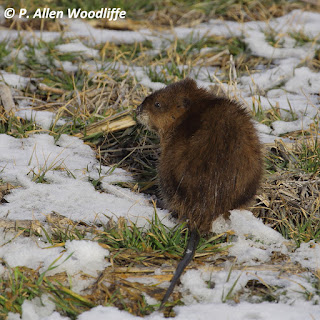With all the ups and downs of the weather, I am sure the waterfowl (maybe humans also!) are just wondering what in the heck is going on. There was a lot of waterfowl around at the beginning of January. By late January, with the weather taking a nose dive, much of the open water became ice covered and some of the waterfowl disappeared for warmer climes, presumably. Then we had a warm spell, with rain, and much of Lake Erie, Rondeau Bay and the Thames River was quite open. Lots of waterfowl returned, and this time included the deluge of Snow Geese along with a few Ross's and Greater White-fronted Geese. Then the polar vortex hit us about a week ago, leaving very little open water anywhere. The birds that did stay could be seen huddled around whatever open water there was, or in flight moving from one open patch to another. That was the state of things for most of this week, so I went looking for open water to see what was there.
A trip to St. Clair NWA proved fruitless. Everything in view was frozen solid, with not a single duck or goose to be seen anywhere, not even in the surrounding fields searching for food.
I moved on to the Jeannette's Creek boat launch at the Thames River. Different location, but same story.
Next stop was the mouth of the Thames River at Lighthouse Cove. Surely there would be something there, even if it was just a handful of the domesticated Mallards!
And there they were. Not the domesticated Mallards, but more than a thousand waterfowl. Unfortunately they were packed in to a relatively small opening in the ice, about 400-500 metres from the viewing point. They were stretched out in a long line, so this first image just shows a portion. Beyond the waterfowl is ice right to the horizon!
An initial quick scan determined that most were clearly Canada Geese, not surprisingly. A few Tundra Swans were mixed in. A closer look is always worthwhile, and in doing just that, I came across a few Canvasback, Mallard, Greater Scaup, Redhead and a single American Coot. And Snow Geese.
It seems that Snow Geese are scattered with almost every flock of waterfowl in extreme southwestern Ontario right now. I counted about 28 Snows, and also saw at least 4 good examples of Ross's Goose, plus at least half a dozen Ross's X Snow hybrids. Unfortunately with the bright sun reflecting off the snow and ice playing havoc with the camera's ability to focus clearly over that distance, the image above is the best I got.
I moved on, deciding to head towards Lake Erie. Given the alteration of the landscape, it was not surprising to find clusters of non-native birds.
 |
| European Starlings and Rock Pigeon |
At Erieau, there was some open water in the main channel and part of the harbour area towards Rondeau Bay. Ducks and geese there were a-plenty, although not often close enough for the photographic results that I was hoping for.
I only saw 6 American Coot. The numbers have dropped considerably from the ~4000 that were in the area on the Christmas Bird Count in late December.
 |
| American Coot |
 |
| Bufflehead |
 |
| Common Goldeneye |
On the return home, I stopped in at the warm water outlet of the Chatham water treatment plant along the Thames River. It was a good decision.
The winter resident Belted Kingfisher was still there, perched on a branch right over the water outlet. I could park close enough and open the car door so as not to spook it.
 |
| Belted Kingfisher ♀ |
 |
| Green-winged Teal |
 |
| Wood Duck |



What a spectacular photo of the Snowy!
ReplyDeleteThanks....they are pretty impressive birds, no question!
DeleteOur weather certainly tends to go from one extreme to the next. Little in between.
ReplyDeleteThose Wood Ducks look nice against the ice. Saw one today north of Sombra!
Indeed, the weather has been predictably up and down, as it was forecast to do. So I am hoping an early spring, with not a lot of precip is also on target (with maybe a decent day or two on most weekends to boot)!
DeleteWood Ducks are impressive at any time of the year when they are in their breeding finery, and certainly brightens up an icy setting.